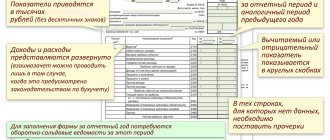In the latest issue of accounting educational program, Alexey Ivanov talks about what revenue, cost, commercial and administrative expenses, other income and expenses are. This classification helps you understand how you make money and what you spend it on. It underlies the grouping of income and expenses in one of the main forms of accounting reporting - the financial performance report. And it helps a lot in management reports.
Hi all! Alexey Ivanov is with you, the knowledge director of the online accounting “My Business” and the author of the telegram channel “Accounting Translator”. Every Friday on our blog on Klerke.ru I talk about accounting. I started with the basics, then I will move on to more complex matters. For those who are just preparing to become an accountant, this will help them get to know the profession better. Seasoned chief accountants should look at familiar categories from a different angle. Last time we figured out the concepts of income and expenses, today I’ll introduce them to their types.
Let's start with income. Income in accounting is divided into revenue and other income.
Revenue
Revenue (Sales Revenue or simply Sales) is income from the company’s normal activities. It is income, not the flow of money. Last time I talked in detail about how these categories differ.
What is considered normal activities is determined by the company itself. The main rule here is systematic income generation. If a product, product, work or service is sold regularly, its sale is a normal activity.
Here's what brings in revenue in different businesses:
- store - sales of purchased goods;
- plant - sales of its own products;
- broker - sales of securities;
- hairdresser - hairdressing services;
- leasing company - renting out property.
In this case, a company may have several normal activities. A grocery store can start producing salads that will be sold along with purchased goods. And the plant sells not only its products, but also purchased spare parts for them. Such sales will also generate revenue.
Once again, I would like to focus on the moment of revenue recognition. Revenue arises in accounting at the moment of transfer of ownership of a product or product from the seller to the buyer. For works and services, the moment of revenue recognition is the date of signing the act of their completion.
The amount of revenue is equal to the amount of the buyer's receivables arising. If the purchase is paid for at the time of purchase, the proceeds coincide with the amount of cash received. If the purchase is partially paid, the proceeds consist of the payment amount and the balance of receivables. This is the so-called “dirty” revenue or gross revenue. It may contain VAT and excise taxes, which will need to be returned to the state. The financial statements reflect net revenue from which these taxes are excluded so that the real income of the company can be understood.
Example 1. A car dealership sold a new Gelendvagen for 12 million rubles. According to the terms of the contract, the client pays half of the cost immediately, and the second half within a year from the date of purchase. Gross revenue consists of 6 million rubles. paid money and 6 million rubles. debtors. Net revenue - 10 million rubles. The remaining 2 million rubles. VAT is the income of the state, not the car dealership.
Write-off and distribution of general business expenses
Account 26 does not have a balance, so everything that has accumulated on it must be written off to other accounts at the end of the month.
The choice of cost write-off option depends on the method of generating product costs:
- Full production cost.
- Reduced cost (method called direct costing).
Which method of cost formation the accountant will choose must be indicated in the accounting policy, otherwise the organization is obliged to form the full production cost of the product.
When an accountant chooses the accounting method at full production cost, general business expenses are written off as a debit to account 20 “Main production”.
If an organization uses account 23 “Auxiliary production” to register auxiliary costs, or if the organization’s balance sheet has servicing facilities (dormitories, kindergartens, sanatoriums, etc.) and account 29 “Service production” is used, then general business expenses can also be written off to the debit of account 29 expenses.
Expenses can be written off to the debit of these accounts only if the servicing industries and farms performed work and services outsourced.
The entries that form the reflection of such transactions in accounting will look like this:
Dt 20 (23, 29) Kt 26
Find out how to reflect the distribution of general business expenses in the accounting of a production organization in ConsultantPlus. If you do not have access to the K+ system, get a trial online access for free.
The choice of the order of distribution of general business expenses between the above accounts remains with the accountant: general business expenses can be distributed among production in proportion to wages, the amount of direct costs or revenue. Which option the accountant chooses must be indicated in the accounting policy.
Example
A construction company has a fleet of vehicles on its balance sheet, the vehicles of which are used to deliver building materials to the company’s facilities and to provide services to third parties.
The company's accountant provided in its accounting policy that the expenses accumulated on account 26 are distributed in proportion to the amount of direct costs for maintaining the main and auxiliary production.
The company's costs associated with providing construction and installation services to clients amounted to RUB 1,800,000.
The construction company's expenses for the vehicle fleet amounted to 200,000 rubles.
2,000,000 rub. (1,800,000 + 200,000) is the total amount of expenses.
The amount of general business expenses is equivalent to 500,000 rubles.
The calculation of the distribution coefficient will look like this: 500,000 / 2,000,000 = 0.25.
The accountant needs to make the following entries:
- Dt 20 Kt 26 - 450,000 (1,800,000 × 0.25) - the estimated share of general business expenses is included in the cost of construction and installation work.
- Dt 23 Kt 26 - 50,000 (200,000 × 0.25) - the cost of providing motor transport services to third-party organizations includes the share of expenses from account 26.
When an accountant chooses the method of accounting for products at reduced cost, the contents of account 26 are written off directly to account 90-2 “Cost of sales”. This creates the following wiring:
D 90-2 Kt 26
You can learn more about accounting for account 90 by reading the material “Account 90 in accounting (nuances).”
Other income
Other Revenue is any company income other than revenue:
- rent (for the lessor);
- dividends;
- income from the sale of fixed assets;
- interest on deposits;
- present.
The moment of recognition and measurement of the amount of other income are determined in the same way as for revenue. The exception is gifts. There is no receivable due to a gift, so income is determined based on the market value of the gifted asset.
The division of income into revenue and other income depends on what the company does. For a store, rent is other income, and for a leasing company, it is revenue. The accrued dividends will be revenue for the qualified investor, but other income for the plant. And only gifts qualify as income except from a professional kept woman.
What is a service for managing apartment buildings?
In accordance with clause 2 of Article 162 of the Housing Code of the Russian Federation, the management company, under an agreement for the management of apartment buildings, on the instructions of the owners of premises in this building, for a certain fee, undertakes to perform work and provide services for the management of an apartment building .
This does not mean one service, but a whole range of works and services, the implementation of which is the responsibility of the management company under the house management agreement. Clause 4 of the MKD Management Rules lists a list of works and services for managing the house.
Read more about apartment management services and associated costs here.
Cost price
Let's move on to the classification of expenses. The first type of expense is cost (Cost of Goods) . These are the costs of manufacturing and selling products, performing work, and providing services. Next I will talk about products, meaning work and services too.
It seems like a simple definition, but it is important to understand that the cost varies. Each of the calculated costs is analyzed for its own purposes. And, if the cost of production is 100 rubles, and the sales revenue is 150 rubles, the profit from sales is not necessarily 50 rubles. Such information is not enough - you need to clarify exactly what cost we are talking about.
Manufacturing cost is the cost of making a product. It needs to be counted and broken down into components in order to understand what can be tweaked in the production process. Reduce waste of materials, switch to cheaper analogues, organize work more efficiently to reduce labor costs, etc.
The monthly production cost shows how much it cost to produce. But it is useless to compare it with revenue for three reasons.
- It is not enough to produce products, they must also be sold. And before it sells, store it somewhere. And all these are additional expenses that affect the financial result.
- Products that were started to be produced this month are not always released in the same month. The costs are already there, but there are no products yet. Such costs in accounting are called work in progress. And this is your asset.
- Products produced in a month are not always sold in the same month. This applies only to products; it is not relevant for works and services. If the products remain in stock, this is your asset.
When you look at the income statement, what you see is the manufacturing cost of goods sold. If you have a trading organization, everything is simpler. Instead of manufacturing cost, there is the cost at which you purchased the resold goods. In accounting, it is called the actual cost of goods.
Cost of sales (full cost) is the cost of manufacturing and selling products. Cost of sales consists of the production cost of products sold and the costs of selling them. It is this cost that must be compared with revenue to correctly determine the financial result.
Example 2. Horns and Hooves LLC produces cakes. During the day, 3 cakes were made and sold. To prepare them, food was purchased for 500 rubles, another 1000 rubles. was the pastry chef's salary. Cakes are sold on Instagram for 1000 rubles. The advertisement cost 2,000 rubles.
Production cost: 1500 rub. (500 rub. + 1000 rub.).
Cost of sales: 3500 rub. (1500 rub. + 2000 rub.).
Sales loss: 500 rub. (3000 rub. - 3500 rub.).
If the owner, when determining the financial result, was guided by production costs, he would decide that he owns a profitable business. But that's not true.
Example 3. Same conditions, but 2 cakes sold.
Production cost of production: 1500 rubles.
Cost of sales: 3000 rub. (2 * 500 rub. + 2000 rub.)
Sales loss: 1000 rub. (2000 rub. - 3000 rub.)
Another 500 rub. — production cost of the cake remaining in the warehouse. If tomorrow they buy it without advertising, then it will bring a profit of 500 rubles.
Closing account 26 in 1C
At the end of the month in 2022, indirect expenses accounted for on account 26 ceased to be distributed. A balance remains on account 26 and is not closed. What could be the problem?
Since 2022, the methodology for closing account 26 has changed in 1C. Regardless of the settings of Accounting Policy 26, the account is written off monthly as expenses (Dt 90.08 or Dt 90.02) and is NOT distributed. Count 26 should NOT be in the distribution rules. The entry must be deleted if it exists.
Main – Accounting Policies – Special Distribution Rules
Account entry 26 for 2022 is redundant. Even if it is indicated that the distribution base is not distributed :
The main thing – Chart of accounts – Account 26 (double click)
You also need to check that the checkbox indicating this is a group account is not accidentally checked:
Operations – Month End
After making changes, you need to sequentially cancel month closing from January 2022, perform month closing for the period from January to the current month:
From 2022, all management costs are fully included in expenses in Dt 90 and more are NOT distributed in Dt 20 (clause “d”, clause 26 of FSBU 5/2019).
In version CORP 26, the account can be distributed in Dt 90.08 among Nomenclature groups in proportion to the distribution base specified in the Accounting Policy. To do this, in the Chart of Accounts
Nomenclature groups
is added to account 90.08.1 manually .
There are no plans to introduce such functionality in the PROF version. To access the section, log in to the site.
See also:
- Clarifications on the mandatory application of FSB 5/2019 “Inventories” from 2021
- Closing cost accounts from 2022 taking into account FSBU 5/2019 (PROF)
- Closing cost accounts from 2022 taking into account FSBU 5/2019 (KORP)
- Management reserves
- Example of accounting policies for production, trade, works, services (simplified methods) (OSN)
- [06/08/2021 entry] Practice of application of FSB 5/2019 Inventories in 1C - Part 3
Did the article help?
Get another secret bonus and full access to the BukhExpert8 help system for 14 days free of charge
Related publications
- Management reserves...
- Direct production costs (account 20) from 2022 ...
- Indirect production costs (account 25) from 2022 ...
- Selling expenses (account 44) ...
Business expenses
Selling Expenses are the costs of selling goods, products, works, and services. The composition of such expenses depends on what the company does.
If a company manufactures products, then selling expenses begin as soon as the products are released. Commercial expenses will include:
- storage of products (rent or depreciation of warehouses, salaries of storekeepers and loaders);
- promoting it to the buyer (marketing and advertising, services of intermediary sellers);
- shipment (packaging, delivery, export customs clearance, insurance en route).
If a company performs work or provides services, then commercial expenses will be mainly those associated with their promotion. There is simply nothing to store and ship.
If a company sells goods, then almost all costs associated with trade are commercial, except for the cost of the goods themselves:
- procurement (remuneration to intermediary suppliers, customs clearance of imports, insurance during transit);
- delivery (of purchased goods to your warehouse/store and sold goods to the buyer);
- salary (from the director to the salesperson - everyone is involved in sales);
- depreciation or rental of buildings, equipment and vehicles;
- marketing and advertising;
- entertainment expenses;
- warranty repair costs;
- any other costs for storage and shipment of goods.
As you can see, the list of commercial expenses for trading organizations is wider than for manufacturing organizations. Therefore, the share in the financial results report is higher. For example, in the financial statements of the Magnitogorsk Iron and Steel Works for 9 months of 2019, commercial expenses amount to 7% of revenue. And in the same reporting X5 Retail Group - 13%.
Results
The legislative acts of the Russian Federation do not contain a clear list of commercial costs. Based on the established practice of Russian accounting, commercial expenses should be attributed to account 44. Based on this principle, commercial expenses can be recognized as those costs that are listed in the instructions to the Chart of Accounts in the description of account 44.
For more information on how an organization can create its own working chart of accounts and which accounts to include in it, read this publication.
Sources: Order of the Ministry of Finance dated October 31, 2000 No. 94n
You can find more complete information on the topic in ConsultantPlus. Free trial access to the system for 2 days.
Administrative expenses
Administrative Expenses are expenses that are not related to the production, storage and marketing of products, but are necessary for the functioning of the organization. They are also called general economic ones.
This includes:
- salaries of managers and other office employees: from accountant to cleaner;
- office maintenance costs: from coffee and cookies to depreciation or rent;
- communication costs: Internet, telephony, postal correspondence;
- costs of assessment, audit and other consulting services;
- transportation costs for office plankton: from maintaining the director’s personal staff to a corporate taxi or travel tickets at the expense of the company;
- entertainment expenses, if it is not possible to correlate them with the sale of specific goods;
- any other expenses not related to the production, storage or sale of products.
The list of administrative expenses for a particular enterprise depends on the specifics of its activities. For example, for most businesses, an accountant’s salary is a general business expense, but in our online accounting “My Business” it is included in the cost of the service. For a call center, the cost of telephony is a production cost, and for a factory it is a general business expense.
As you can see, management expenses are mainly aimed at maintaining administrative and management personnel and office infrastructure. When I started my career at the plant, the shop floor people called such employees parasites. Because they do not produce products and do not sell them. And you need to feed them.
There is some truth to this. Administrative expenses, as a rule, are semi-fixed. That is, they do not depend on output volumes. This means they should be as small as possible. And one interesting fact is connected with this.
In the income statement, administrative expenses can be shown either in cost of sales or as a separate line item. And here are two examples.
- Private Norilsk Nickel.
- State RusHydro.
In the first case, administrative expenses are shown as a separate line. It is immediately clear that for 1 rub. the cost of production accounts for 14 kopecks in administrative expenses. In the second case, management costs are buried in the cost price. Why it is so big is unclear. Maybe the resources are expensive, or maybe the directors receive huge salaries.
By the way, the new FSBU “Reserves”, although it will not be released in the form in which the Ministry of Finance should have adopted it, prohibits the inclusion of management expenses in the cost of production. As Peter the Great said: “So that everyone’s stupidity can be seen.”
Tax accounting
Any company expenses, including management expenses, are taken into account for tax purposes. To be taken into account, they must meet the following conditions:
- The costs are rational from an economic point of view.
- Expenses are confirmed by primary documentation. All expenses are included in tax accounting only on the basis of information from accounting.
- The main purpose of expenses is the profit of the enterprise in the future.
Expenses will be reflected in the period to which they belong.
FOR YOUR INFORMATION! When tax accounting for management expenses, specialists have many questions. For example, many do not know whether the following UR periods are considered expenses if there is no profit. When analyzing tax regulations, we can conclude: UR for tax purposes are recognized only in expenses of the current reporting period. In accounting, the company independently determines the procedure for recognizing expenses and records this in its accounting policies.





